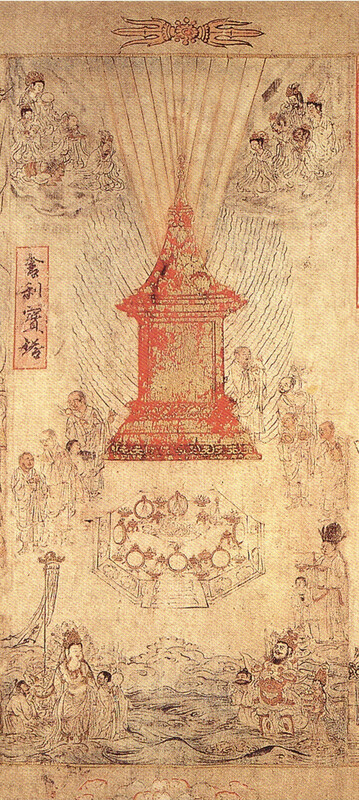The pagoda is painted in gold (part of which has come off, showing a beautiful clear red underneath). From it emerge two different kinds of rays: from the two sides rays close together, a wavy line alternating with a straight one; and from the finial a series of straight rays, spaced at greater intervals. The lower rays curve to form an elliptical halo, while the upper form a triangle with its base at the top of the picture. The stūpa rests on a lotus pedestal. Its square top, which projects almost as widely as the base, supports a cone-shaped structure, ending in a lotus which holds a cone-shaped receptacle in the mouth of which a three or five pointed vajra stands upright.
Above, on clouds, are two groups, the one on the right consisting of three men and two women, and the one opposite of two men, two women, and a peculiar hairy individual, apparently on all fours.
In front of the stūpa is a low octagonal table with steps in front, on which are many ritual vessels surrounding a bowl of lotuses. There are eight circular objects on stands — mirrors or small drums — bowls of lotus flowers, and incense burners.
To the right of the stūpa are four monks, one with a conch, one with a vase of lotuses, one with cymbals, and one with a gong. To the left are three monks, one with a fly-whisk, one with his hands in añjali mudrā, and the third holding a rosary, together with a boy attendant carrying a large box.
In front is water, from which emerges, to the right, a Nāga king in armor, apparently with six heads (an unprecedented number), holding a sword and attended by a Nāga official and a Nāgini carrying a bowl of jewels. To the left is his queen facing him, with seven snakes' heads, holding a flowering branch and attended by an official and a Nāga with one snake head above his human one, carrying a vase from which issue rays, and a monster holding a banner. The banner is twice the height of the queen, and has long streamers.
On the shore behind the Nāga with the vase is something that looks like a huge toad. On the shore to the right, behind the Nāga king, is a human official, probably representing some real person, wearing a large black hat and holding an incense burner, attended by a boy. The king, the queen, and their attendants are in water up to their knees. The human official is likely to be a Nanzhao ruler. His relatively wide and low, beehive-shaped tiara corresponds with those worn by the later monarchs of the dynasty, as shown in frame 103. The correspondence is closest with the 10th ruler on that frame, Meng Quanfengyou.
舍利寶塔 the Precious Pagoda for Relics |



